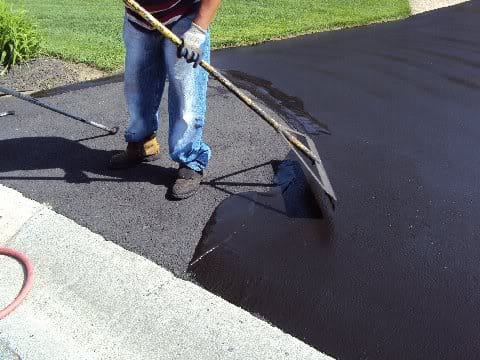Unlock the Secrets of Asphalt Sealing: Maximizing Hot Mix Asphalt Durability
Wiki Article
Warm Mix Asphalt: A Lasting Solution for Pavement
Warm Mix Asphalt (HMA) has actually arised as a leading lasting selection for pavement solutions, providing a myriad of ingenious modern technologies and ecological benefits. Its capability to reduce and reuse products power consumption offers an engaging case for its adoption in road building and construction projects. The long-lasting performance and toughness of HMA make it a recommended alternative for framework development. As the demand for environment-friendly building and construction methods grows, checking out the nuances of HMA's sustainability can give valuable understandings right into the future of sidewalk remedies.Ecological Benefits of Warm Mix Asphalt

Moreover, Hot Mix Asphalt aids to alleviate city heat island effects. Its dark color takes in sunlight, lowering the quantity of warmth reflected back into the atmosphere compared to lighter-colored sidewalks. This can reduce ambient temperature levels in metropolitan locations, reducing the need for cooling and eventually decreasing energy usage.
On top of that, Hot Mix Asphalt contributes to boosted stormwater monitoring. Its porous nature allows water to infiltrate the sidewalk and charge groundwater materials, minimizing runoff and the danger of flooding. These environmental benefits make Hot Mix Asphalt a sustainable option for leading roadways and highways.
Energy Effectiveness in HMA Production
Is power performance an important aspect in the manufacturing of Hot Mix Asphalt (HMA)? Power plays a substantial function in the manufacturing of HMA, affecting both cost and ecological sustainability. One crucial element of power performance in HMA manufacturing is the use of cozy mix asphalt (WMA) innovations.Furthermore, advancements in plant technologies have actually led to even more energy-efficient HMA production processes. By enhancing power usage in HMA production, the market can reduce its carbon footprint while preserving high-quality pavement products.
Recyclability of Warm Mix Asphalt
The recyclability of Warm Mix Asphalt (HMA) is a critical element of its sustainability and long-term ecological effect. HMA is among the most recycled materials in the USA, with over 100 million bunches of redeemed asphalt pavement (RAP) being reused each year in new pavement construction. Reusing HMA supplies several environmental benefits, such as minimizing the need for virgin materials, reducing power intake throughout production, helpful hints and decreasing the quantity of waste sent out to garbage dumps.The process of reusing HMA includes milling the existing sidewalk, squashing it into smaller items, and blending it with brand-new accumulation and asphalt binder to create a recycled mix. In general, the recyclability of HMA plays a significant duty in promoting sustainable techniques within the sidewalk market.

Long-Term Performance of HMA
Asphalt pavements demonstrate longevity and durability over an extensive period, reflecting the long-lasting efficiency of Warm Mix Asphalt (HMA) The long life of HMA can be credited to its capacity to hold up against heavy web traffic tons, extreme weather, and the impacts of aging. Research studies have actually shown that properly designed and properly created HMA pavements can last for twenty years or even more with regular upkeep. The trick to maximizing the long-term efficiency of HMA hinges on utilizing premium materials, complying with ideal practices in construction, and implementing reliable upkeep methods. Appropriate drain, routine inspections, and prompt repair services are necessary for protecting the structural integrity of HMA sidewalks gradually. Furthermore, advancements in HMA modern technology, such as using polymer-modified binders and warm mix asphalt, have better improved the resilience and long life of HMA pavements. By prioritizing high quality building and upkeep methods, HMA remains to confirm itself as a sustainable and cost-efficient solution for resilient pavement facilities.
HMA: Sturdiness and Sustainability
Demonstrating both longevity and sustainability, Warm Mix Asphalt (HMA) has actually ended up being a cornerstone in the building of long-lasting sidewalk infrastructures - hot mix asphalt. HMA's toughness originates from its capability to withstand hefty loads, extreme climate condition, and high traffic quantities, making it a dependable selection for roadways, highways, and airport terminal runways. The make-up of HMA, which generally consists of aggregates, binder, and filler, plays a vital role in enhancing its durability and resistance to tear and use
In addition, HMA's sustainability depends on its recyclability and energy-efficient production procedure. The capability to reuse recovered asphalt sidewalk (RAP) in brand-new HMA mixtures decreases the need for Your Domain Name virgin materials and minimizes the environmental effect of sidewalk building and construction and maintenance. Furthermore, the power efficiency of producing HMA depends on its lower mixing temperatures compared to other pavement materials, causing lowered energy intake and greenhouse gas emissions.
Final Thought
In verdict, hot mix asphalt (HMA) provides a sustainable service for pavement with its environmentally pleasant characteristics. HMA's recyclability, power effectiveness in production, and lasting durability make it an environmentally friendly option for roadway building and construction.
HMA is one of the most recycled materials in the United States, with over 100 million loads of redeemed asphalt pavement (RAP) being recycled each year in new sidewalk building.The process of reusing HMA involves crushing the existing pavement, squashing it into smaller sized pieces, and blending it with new accumulation and asphalt binder to develop a recycled mix.Asphalt sidewalks demonstrate longevity and durability over an extensive period, mirroring the long-term efficiency of Hot Mix Asphalt (HMA) Furthermore, advancements in HMA modern technology, such as the use of polymer-modified binders and cozy mix asphalt, have actually further improved the resilience and longevity of HMA pavements. The capacity to recycle reclaimed asphalt sidewalk (RAP) in Get More Information new HMA mixes lowers the demand for virgin materials and decreases the environmental influence of sidewalk building and construction and maintenance.
Report this wiki page